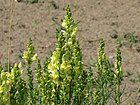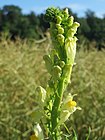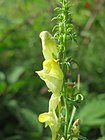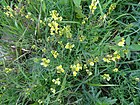Note: This is a project under development. The articles on this wiki are just being initiated and broadly incomplete. You can Help creating new pages.
Difference between revisions of "Linaria vulgaris - Yellow toadflax"
Chaithrika (talk | contribs) (+Common names) |
|||
| Line 3: | Line 3: | ||
'''Linaria vulgaris''' ('''common toadflax, yellow toadflax, or butter-and-eggs''') is a species of toadflax (Linaria), native to most of Europe, northern Asia, the United Kingdom, Spain, east to eastern Siberia, and western China.<ref name="int"/> It has also been introduced and is now common in North America. | '''Linaria vulgaris''' ('''common toadflax, yellow toadflax, or butter-and-eggs''') is a species of toadflax (Linaria), native to most of Europe, northern Asia, the United Kingdom, Spain, east to eastern Siberia, and western China.<ref name="int"/> It has also been introduced and is now common in North America. | ||
| − | == | + | ==Uses== |
| + | {{Uses|Wounds}}, {{Uses|Cuts}}, {{Uses|Snakebites}}, {{Uses|Curing liver disorders}}, {{Uses|Skin eruptions}}, {{Uses|Blotches}}, {{Uses|Pimples}}, {{Uses|Diarrhea}}, {{Uses|Sore throats}} | ||
| + | |||
| + | ==Parts Used== | ||
| + | {{Parts Used|Dried Folaige}}, {{Parts Used|Whole herb}}. | ||
| + | |||
| + | ==Chemical Composition== | ||
| + | The ability of Linaria vulgaris (Scrophulariaceae) infusion to act as a scavenger of 2,2-diphenyl-1-picrylhydrazyl (DPPH) radical, reactive oxygen species (superoxide radical, hydroxyl radical, hypochlorous acid (HOCl)) and nitric oxide was investigated.<ref name="chemical composition"/> | ||
| + | |||
| + | ==Common names== | ||
| + | {{Common names|kn=|ml=|sa=|ta=|te=|hi=|en=Agrimony}} | ||
| + | |||
| + | ==Properties== | ||
| + | Reference: Dravya - Substance, Rasa - Taste, Guna - Qualities, Veerya - Potency, Vipaka - Post-digesion effect, Karma - Pharmacological activity, Prabhava - Therepeutics. | ||
| + | ===Dravya=== | ||
| + | |||
| + | ===Rasa=== | ||
| + | |||
| + | ===Guna=== | ||
| + | |||
| + | ===Veerya=== | ||
| + | |||
| + | ===Vipaka=== | ||
| + | |||
| + | ===Karma=== | ||
| + | |||
| + | ===Prabhava=== | ||
| + | |||
| + | ==Habit== | ||
| + | {{Habit|Herb}} | ||
| + | |||
| + | ==Identification== | ||
| + | ===Leaf=== | ||
| + | {{Leaf|Simple|opposite|Stalkless. Blade linear, sharp-tipped, margins revolute.}}<ref name="Leaf"/> | ||
| + | |||
| + | ===Flower=== | ||
| + | {{Flower|Unisexual|25–30 mm|orange|5-20|Flower is Irregular (zygomorphic). Corolla yellow, fused, bilabiate, spurred}} | ||
| + | |||
| + | ===Fruit=== | ||
| + | {{Fruit|simple|7–10 mm|clearly grooved lengthwise, Lowest hooked hairs aligned towards crown||many}} | ||
| + | |||
| + | ===Other features=== | ||
| + | |||
| + | ==List of Ayurvedic medicine in which the herb is used== | ||
| + | * [[Vishatinduka Taila]] as ''root juice extract'' | ||
| + | |||
| + | ==Where to get the saplings== | ||
| + | ==Mode of Propagation== | ||
| + | {{Propagation|Seeds}}, {{Propagation|Cuttings}}. | ||
| + | |||
| + | ==How to plant/cultivate== | ||
| + | Succeeds in a moderately good well-drained soil<ref name="How to plant/cultivate"/> | ||
| + | |||
| + | ==Commonly seen growing in areas== | ||
| + | {{Commonly seen|Tall grasslands}}, {{Commonly seen|meadows}}, {{Commonly seen|Borders of forests and fields}}. | ||
| + | |||
| + | ==Photo Gallery== | ||
| + | <gallery class="left" caption="" widths="140px" heights="140px"> | ||
| + | |||
| + | 20150629Linaria vulgaris2.jpg | ||
| − | + | 20150629Linaria vulgaris3.jpg | |
| − | + | ||
| + | 20160627Linaria vulgaris1.jpg | ||
| − | + | ||
| − | + | 20160627Linaria vulgaris2.jpg | |
| − | |||
| − | |||
| − | + | ||
| + | 20150722Linaria vulgaris.jpg | ||
| + | |||
| + | |||
| + | 20160717Linaria vulgaris.jpg | ||
| − | + | ||
| + | Linaria vulgaris Mill. (7616821878).jpg | ||
| − | + | </gallery> | |
| − | <references> | + | ==References== |
| − | <ref name=" | + | |
| − | + | <references> | |
| + | <ref name="chemical composition">[https://www.ncbi.nlm.nih.gov/pubmed/18569715 "antioxidative properties"]</ref> | ||
| − | = | + | <ref name="Leaf">[http://www.luontoportti.com/suomi/en/kukkakasvit/yellow-toadflax "plant charecteristics"]</ref> |
| − | + | <ref name="How to plant/cultivate">[https://www.pfaf.org/user/Plant.aspx?LatinName=Linaria+vulgaris "Cultivation details"]</ref> | |
| + | </references> | ||
| + | ==External Links== | ||
| + | * [https://www.tandfonline.com/doi/abs/10.1080/14786410601132360 Assessing the antioxidative properties and chemical composition] | ||
| + | * [https://www.cabi.org/isc/datasheet/30828 Linaria vulgaris on Invasive Species Compendium] | ||
| + | * [http://www.bioone.org/doi/abs/10.1614/IPSM-D-14-00082.1 Adaptive Development of Yellow Toadflax (Linaria vulgaris) Chemical Control Recommendations] | ||
[[Category:Herbs]] | [[Category:Herbs]] | ||
Revision as of 18:34, 18 May 2018
Linaria vulgaris (common toadflax, yellow toadflax, or butter-and-eggs) is a species of toadflax (Linaria), native to most of Europe, northern Asia, the United Kingdom, Spain, east to eastern Siberia, and western China.[1] It has also been introduced and is now common in North America.
Contents
- 1 Uses
- 2 Parts Used
- 3 Chemical Composition
- 4 Common names
- 5 Properties
- 6 Habit
- 7 Identification
- 8 List of Ayurvedic medicine in which the herb is used
- 9 Where to get the saplings
- 10 Mode of Propagation
- 11 How to plant/cultivate
- 12 Commonly seen growing in areas
- 13 Photo Gallery
- 14 References
- 15 External Links
Uses
Wounds, Cuts, Snakebites, Curing liver disorders, Skin eruptions, Blotches, Pimples, Diarrhea, Sore throats
Parts Used
Chemical Composition
The ability of Linaria vulgaris (Scrophulariaceae) infusion to act as a scavenger of 2,2-diphenyl-1-picrylhydrazyl (DPPH) radical, reactive oxygen species (superoxide radical, hydroxyl radical, hypochlorous acid (HOCl)) and nitric oxide was investigated.[2]
Common names
| Language | Common name |
|---|---|
| Kannada | |
| Hindi | |
| Malayalam | |
| Tamil | |
| Telugu | |
| Marathi | NA |
| Gujarathi | NA |
| Punjabi | NA |
| Kashmiri | NA |
| Sanskrit | |
| English | Agrimony |
Properties
Reference: Dravya - Substance, Rasa - Taste, Guna - Qualities, Veerya - Potency, Vipaka - Post-digesion effect, Karma - Pharmacological activity, Prabhava - Therepeutics.
Dravya
Rasa
Guna
Veerya
Vipaka
Karma
Prabhava
Habit
Identification
Leaf
| Kind | Shape | Feature |
|---|---|---|
| Simple | opposite | Stalkless. Blade linear, sharp-tipped, margins revolute. |
Flower
| Type | Size | Color and composition | Stamen | More information |
|---|---|---|---|---|
| Unisexual | 25–30 mm | orange | 5-20 | Flower is Irregular (zygomorphic). Corolla yellow, fused, bilabiate, spurred |
Fruit
| Type | Size | Mass | Appearance | Seeds | More information |
|---|---|---|---|---|---|
| simple | 7–10 mm | clearly grooved lengthwise, Lowest hooked hairs aligned towards crown | many | {{{6}}} |
Other features
List of Ayurvedic medicine in which the herb is used
- Vishatinduka Taila as root juice extract
Where to get the saplings
Mode of Propagation
How to plant/cultivate
Succeeds in a moderately good well-drained soil[4]
Commonly seen growing in areas
Tall grasslands, meadows, Borders of forests and fields.
Photo Gallery
References
- ↑ Cite error: Invalid
<ref>tag; no text was provided for refs namedint - ↑ "antioxidative properties"
- ↑ "plant charecteristics"
- ↑ "Cultivation details"
External Links
- Pages with reference errors
- Ayurvedic Herbs known to be helpful to treat Wounds
- Ayurvedic Herbs known to be helpful to treat Cuts
- Ayurvedic Herbs known to be helpful to treat Snakebites
- Ayurvedic Herbs known to be helpful to treat Curing liver disorders
- Ayurvedic Herbs known to be helpful to treat Skin eruptions
- Ayurvedic Herbs known to be helpful to treat Blotches
- Ayurvedic Herbs known to be helpful to treat Pimples
- Ayurvedic Herbs known to be helpful to treat Diarrhea
- Ayurvedic Herbs known to be helpful to treat Sore throats
- Herbs with Dried Folaige used in medicine
- Herbs with Whole herb used in medicine
- Herbs with common name in English
- Habit - Herb
- Index of Plants which can be propagated by Seeds
- Index of Plants which can be propagated by Cuttings
- Herbs that are commonly seen in the region of Tall grasslands
- Herbs that are commonly seen in the region of meadows
- Herbs that are commonly seen in the region of Borders of forests and fields
- Herbs







